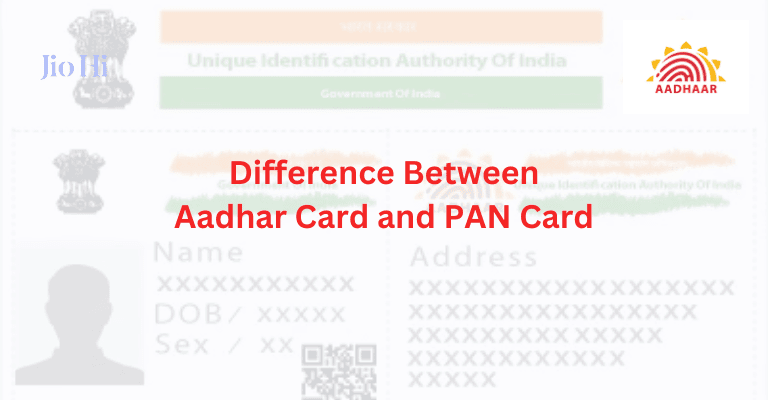What is the difference Between Aadhar Card and PAN Card
 What is the Between Aadhar Card and PAN Card Image
What is the Between Aadhar Card and PAN Card Image
Both Aadhar Card and PAN Card are essential documents for Indian residents, but they serve entirely different purposes. While the Aadhar Card is a proof of identity and address, the PAN Card is primarily used for tax-related transactions. In this blog, we’ll explore what is the difference between Aadhar Card and PAN Card to help you understand their unique roles.
Table of Contents
Why Should You Know the Difference Between Aadhar and PAN?
Understanding the difference between Aadhar Card and PAN Card is crucial because both documents are often required for various financial and government-related transactions. For instance:
- Aadhar is linked to welfare schemes and bank accounts. Learn More
- PAN is mandatory for filing income tax returns and high-value transactions. Read About PAN
Knowing when and where to use each document can save you time and effort.
Key Differences Between Aadhar Card and PAN Card
Below is a detailed comparison of Aadhar Card and PAN Card based on various parameters:
| Parameter | Aadhar Card | PAN Card |
|---|---|---|
| Issuing Authority | Unique Identification Authority of India (UIDAI) | Income Tax Department |
| Purpose | Proof of identity and address | Tax-related identification |
| Mandatory for Citizens | No (but required for many services) | Yes (for taxpayers) |
| Unique Identifier | 12-digit number | 10-character alphanumeric code |
| Biometric Data | Includes fingerprints and iris scans | Does not include biometric data |
| Usage | Welfare schemes, bank accounts, SIM cards | Filing taxes, property transactions, investments |
| Eligibility | Available to all Indian residents | Available to taxpayers and individuals with taxable income |
When to Use Aadhar Card vs PAN Card
Aadhar Card Usage
- Linking with bank accounts for Direct Benefit Transfers (DBT).
- Applying for government subsidies and welfare schemes.
- Verifying identity during SIM card registration or travel bookings.
For more details, read: Role of Aadhar in Government Subsidies and Welfare Schemes .
PAN Card Usage
- Filing income tax returns.
- Conducting high-value financial transactions like property purchases.
- Opening demat accounts or applying for loans.
For guidance on linking Aadhar with PAN, refer to: Linking Aadhar Card with PAN: Step-by-Step Process .
Can Aadhar and PAN Be Linked?
Yes, linking your Aadhar Card with your PAN Card is mandatory for taxpayers. This linkage ensures transparency and reduces tax evasion. Here’s why it’s important:
- It helps the government track financial transactions accurately.
- It simplifies the process of filing income tax returns.
For a step-by-step guide, read: Linking Aadhar Card with PAN: Step-by-Step Process .
External Resources for Aadhar and PAN
For additional assistance, you can explore these external resources:
- Income Tax Department Portal : Check your PAN status or file income tax returns.
- UIDAI Website : Learn more about Aadhar Card services and updates.
FAQs
1. Can I use Aadhar Card as a substitute for PAN Card?
No, Aadhar cannot replace PAN for tax-related purposes. However, Aadhar can be used for KYC verification while applying for a PAN Card.
2. Is it mandatory to link Aadhar with PAN?
Yes, it is mandatory for taxpayers to link their Aadhar with PAN to file income tax returns.
3. What happens if I don’t link my Aadhar with PAN?
If you don’t link your Aadhar with PAN, your PAN may become invalid, and you won’t be able to file income tax returns.
4. Can NRIs apply for both Aadhar and PAN?
NRIs can apply for a PAN Card but not an Aadhar Card, as Aadhar is only available to Indian residents.
5. Which document is more important for financial inclusion?
Both documents are important, but Aadhar plays a larger role in financial inclusion by enabling access to banking and welfare schemes.
While Aadhar Card and PAN Card serve different purposes, they are complementary in many ways. Understanding their differences and knowing when to use each document can help you navigate various financial and government-related processes seamlessly.
For more related topics, explore:
- How to Download Aadhar Card Online
- Aadhar Card Security Features and Data Privacy





